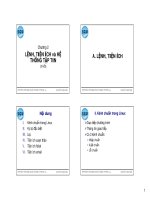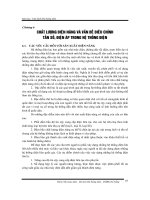TÀI LIỆU VỀ BỐ TRÍ ĐƯỜNG ỐNG VÀ HỆ THỐNG ĐƯỜNG ỐNG NGẦM
Bạn đang xem bản rút gọn của tài liệu. Xem và tải ngay bản đầy đủ của tài liệu tại đây (1.15 MB, 25 trang )
PIPING DOCUMENT
1.Piperack: A Structure for Routing Pipes in the
Plant
In a chemical plant pipes run from one unit to another unit, lines coming from outside
facilities etc. The structure which used for these purpose is termed as Piperack. So while
preparing the plot plan for a plant one of the most important activity is to plan the piperack
through which the piping has to run from one unit to the other.
Generally it is cheaper to run pipes at grade, but only where resulting hindrance to access is
unimportant. The arrangement of pipe rack and structures should be given special attention
as savings in structural steel and civil costs can often be greater than increased cost due to
extra pipe length. Piperack constructionablity (structural or concrete) needs to be freezed at
early stage of project in consultation with client & civil . Piping that needs to be free draining
or ‘no pocket’ will often dictate the levels for elevated structures.
The following types of Pipe racks may be required:
• Interconnecting/Main piperack (elevated)
• Unit piperack (elevated)
• Pipe track or sleeper way (at grade)
Pipe rack example 1
Interconnecting piperacks carry process and utility lines to and from process and utility
units. They should not run through process or utility units. Unit racks connect to the main
rack taking lines into the respective units via a battery limits station. These racks should be
at different elevations to the interconnecting rack.
Unit piperacks are the main arteries carrying the pipes into the units, and as such should
be centrally located and are usually elevated. They should be of sufficient height to allow
vehicle access beneath. The width of rack will be determined by the number of lines (plus
future requirements) it carries, along with any allocation for cable trays.
In offsite areas or where only a few lines are required to run to an isolated plant area it is
more cost effective to run pipes on pipe tracks or sleepers, at grade. Sleeper spacing will
depend on limiting pipe spans. Sleeper piping is also preferred in offsite area as pipe runs
on elevated structure often acts as hindrance for fire protection.
Pipe trenches are used mainly in large offplot storage areas where pipes need to run at
low level and require to pass under plant roads. However use of unfilled open pipe trenches
has to be reviewed considering the draining requirement.
2.Underground Piping (U/G) Piping – Part 2
This device is used to collect surface drainage with an outlet liquid seal and sediment trap.
The sketch Fig 1 illustrates a typical catch basin feature and Fig 2 illustrates a typical
location of catch basins.
The maximum area coverage of a catch basin is approx 150 sqm. ie. 12m x 12m
or15mx10m.
The area covered by a catch basin should be of square configuration, as far as possible.
The catch basin should be located in the middle of the area as far as possible.
Slope of pavement 1 in 100, e.g. HPP (Ridge of catch basin area = 100.00) and LPP (at
catch basin peripheral drain = 99.85)
1. Catch Basin
No catch basins or manholes should be located within 15m radius of heaters. No vent pipes
should be located within 15m of the heaters.
Area drainage around heater areas shall be done by pavement sloping towards open
ditches. Each catch basin shall be connected to manhole and shall be provided with fire
seal.
Fig 1 Catch basin
Fig 2. Plot subdivided into drainage areas
2. Sealed Manholes
Sealed manholes shall be provided at
a. Unit battery limit and
b. Junction of sewers and at change in size of main header.
These devices are provided so that the unit area is isolated from any fire in offsite
area/sewer.
Within the unit area, sealed manholes in main headers should be provided in such locations
so that each subunit within the unit is isolated from the other areas. In case, this
demarcation is difficult, one sealed manhole for every 30m length of main sewer in the unit
shall be provided.
Sealed manhole with bent pipes seal type shall be used for carbon steel pipes upto size16 ″
NB and for greater than dia 16″ NB and for all diameters of RCC pipes double compartment
type manholes should be used.
3. Invert elevation
This term, usually associated with any underground line, refers to the elevation of the inside
bottom of the line. Because of the wide range of materials used in the underground piping
system / drainage system with varying wall thickness, it is the constant that is used to set
the elevation on construction drawings.
The starting invert level of CRWS shall be normally 750mm below HPP (High Point
ofPaving)
The invert level at outlet point of CRWS and OWS shall be normally 1500mm below FGL.
4. Cleanout
A cleanout is a piping connection in a sewer system that is located at grade level for
inspections or for cleaning the system.
5. Vent Pipes
Vent pipes shall be located along piperack columns or building columns and should be
taken 2m above the building parapet or last layer of pipes on a piperack.
6. Valve Pit / Maintenance pit for flanges and instruments.
When the underground system needs valves for isolation and instruments for control, the
normal practice is to enclose these valves and instruments in a RCC pit with cover. These
valves and instruments in a pit can be operated as well as maintenance work can be done
with ease.
Piping arrangementUnderground
Under piping are generally arranged based on the location of the consumers and the also
depends upon the depth for the soil surface. Some of the guidelines for routing of the
underground piping are stated below:
1. The overall Plot Plan allocates the space for the major underground services in the
beginning of the project.
The cooling water supply from cooling water pump discharge to the various units as well as
the cooling water return from the various units to the top of cooling tower is routed in a
simple, straight orientation at a suitable depth avoiding any major road crossings.
A typical cooling water and potable water system is illustrated in sketch Fig 3. Cooling water
cross over piping is illustrated in sketch Fig 4.
Cooling water lines to heat exchangers are typically illustrated in sketch Fig 5.
Cooling water lines to pumps for various cooling requirements is illustrated in sketchFig 6.
2. The potable water system supplies to various units and a branch is taken to the
emergency eyewash and safety shower station as illustrated in sketch Fig 7.
3. Fire water system protects each piece of equipment by providing water through hydrants,
monitors or deluge spray systems.
Each process unit will have its own underground firewater piping loop system.
4. A typical hydrant and monitor installations are illustrated in sketch Fig 9 and a typical fire
monitor is shown in sketch Fig 10.
5. Normally, chemical process units will have multiple drain systems designed to collect all
corrosive or toxic chemical waste as well as surface drainage around the equipment.
Drain / sewer system in a plant can be categorized as:
– Uncontaminated storm water
– Contaminated storm water
– Oily water sewer
– Chemical and process sewer
– Sanitary sewer
– Blowdown system
– Uncontaminated storm water system generally collects all service water from
equipment areas, access ways, roadways to equipment. This collection is done through
area drains, catch basins, roof rain water downcomers.
– Contaminated storm water system collects surface drainage from areas
containing hydrocarbon processing equipment. This system water must pass through a
treatment facility before being discharged into an uncontaminated system or natural body of
water viz. river or a stream connected to a river.
– Oily water sewer system collects waste, drips, leaks from equipment and piping in
noncorrosive process equipment area. The designer should identify all the specific drain
points in consultation with the process engineer.
– Chemical and process sewer system recovers acid or chemical drains from
equipment / piping as well as surface drainage by providing curbing and drain sump around
such equipment.
– Sketch UGP19 depicts a typical process drains – closed system.
– Sketch UGP21 illustrates a typical crosssection of a closed or chemical drain
system.
– Sanitary sewer system collects raw waste from lavatories and is either connected to
the municipal battery limit or routed to a septic tank.
– Blowdown system picks up drains around boilers and steam drums and is run as a
separate system. It is permissible to connect the blowdown system to a sewer box in oily
water sewer system downstream of drainage from a furnace.
6. Trench Piping
Occasionally, drain piping or process piping should be run below grade but not buried.
Sketch Fig 8 illustrates two insulated lines A and B running below grade to a drain tank.
The top of the trench is covered with grating but could be covered with RCC slab
depending on the traffic load estimated in the area.
The width of trench should allow adequate clearance to valves and drains as required.
7. A typical catch basin is illustrated in sketch Fig 11.
A typical sewer box or manhole is illustrated in sketch Fig 12. A typical Dyked area drain
sump is illustrated in sketch Fig 13.
A typical lift station by vertical pump is illustrated in sketch Fig 14.
8. A process area for the purpose underground drainage is subdivided into block areas with
high point ridge and low point catch basins / pits.
The low point catch pits are connected to manholes.
The manholes are interconnected by sloping piping and led to the battery limit valve pit and
finally discharged into the treatment pond.
Sketch Fig 1516, Fig 1718, Fig 19 illustrates the details of the subdivision of the process
area into blocks with explanatory notes.
Sketch Fig 20 illustrates how to handle oily water and storm water system.
9.Closed drain system is illustrated by various sketches Fig 2122, Fig 23, Fig 24.
10.The underground electrical and instrument cables passing under a road or paved area is
takenthrough ducts embedded in lean concrete. Sketch Fig 25 shows a typical arrangement
of such underground cabling details.
Fig 3 Process cooling water and potable water system
Fig 4. Cooling water crossover piping
Fig 5 Cooling water to exchangers
Fig 6. Cooling water to pumps
Fig 7 Emergency eyewash and safety shower
Fig 8. Trench piping
Fig 9 Hydrant and monitor installations
Fig 10 Typical grademounted fire monitor
Fig 11 Catch basin
Fig 12 Typical sewer box or manhole
Fig 13 Dyked area drain
Fig 14. Lift station
Fig 15. Indicative PFD for oily waste sewer & contaminated rain water sewer & process
line
Fig 16. Notes: Indicative PFD for oily waste sewer & contaminated rain water sewer &
process line
Fig 17.G.A.for underground piping
Fig 18.Notes: G.A.for underground piping
Fig 19. Plot subdivided into drainage areas
Fig 20. Oily water and storm water system
Fig 21.Process drains: Closed system
Fig 22. Plan for a closed drain system
Fig 24 Closed drain system Sump
Fig 23.Closed drain system : Cross section
Fig 25 Underground cable duct









